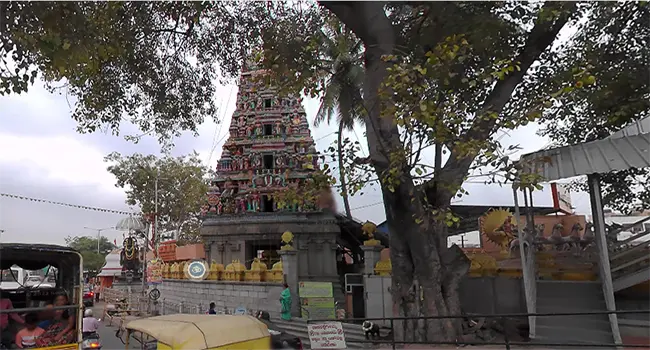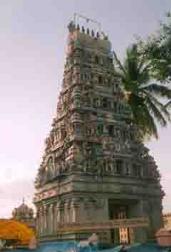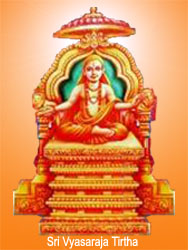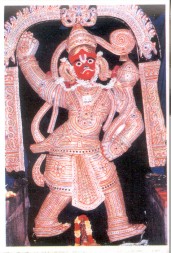
Bangalore [Bengaluru] and Kempe Gowda I
 The present city of Bangalore [Bengaluru] was then part of the Vijayanagar Empire. It is known that
Kempe Gowda-I (1513-1569), the ruler of Yelahanka province, feudatory to the Vijayanagar rulers was
instrumental in giving shape to this modern city. He had been a great builder of tanks and temples. He
had planned the modern Bangalore [Bengaluru] and built it in 1527. Kempe Gowda I, who was in charge of
Yelahanka, built a mud fort in 1537. With the help of King Achutaraya, he built the little towns of
Balepet, Cottonpet, and Chickpet, all inside the fort. Today, these little areas serve as the major
wholesale and commercial marketplaces in the City.
The present city of Bangalore [Bengaluru] was then part of the Vijayanagar Empire. It is known that
Kempe Gowda-I (1513-1569), the ruler of Yelahanka province, feudatory to the Vijayanagar rulers was
instrumental in giving shape to this modern city. He had been a great builder of tanks and temples. He
had planned the modern Bangalore [Bengaluru] and built it in 1527. Kempe Gowda I, who was in charge of
Yelahanka, built a mud fort in 1537. With the help of King Achutaraya, he built the little towns of
Balepet, Cottonpet, and Chickpet, all inside the fort. Today, these little areas serve as the major
wholesale and commercial marketplaces in the City.
Western boundary of Bangalore [Bengaluru]
It is customary that new cities used to be built by the rulers on the banks of some river. Incidentally, this city of Bangalore [Bengaluru] was also built on the banks of the rivers Vrishabhavathi and Paschimavahini. The river Virshabhavathi forms the western boundary of the Bangalore [Bengaluru] City. Today not many know about these two rivers or the fort. If you move from the city market on the Mysore road you will come across the Sangam of these rivers. Old Bangaloriens will tell you that till about the early sixties water was flowing through the river Vrishabhavathi and today only industrial waste is flowing making it look more like a gutter, than a river.
Saint Sri Vyasaraja
 Sri Yatiraja born near the place Chennapatna on taking up the sanyasa came to be known by the
name Sri Vyasaraya Tirtha. He is also known as Sri Vyasaraja Tirtha since Sri Krishnadevaraya had
given away his rajya to this saint. He was Rajaguru of the Vijayanagar Empire. The Empire went
from Saluvas to Thaulavas. But Sri Vyasaraya Tirtha remained the Rajaguru for these two dynasties. Sri
Vyasaraja Tirtha was a great philosopher and was devoted to Lord Anjaneya. He had built around 732
temples for the Lord. He had been frequenting areas around Mysore Chennapatna, (present) Bangalore
then.
Sri Yatiraja born near the place Chennapatna on taking up the sanyasa came to be known by the
name Sri Vyasaraya Tirtha. He is also known as Sri Vyasaraja Tirtha since Sri Krishnadevaraya had
given away his rajya to this saint. He was Rajaguru of the Vijayanagar Empire. The Empire went
from Saluvas to Thaulavas. But Sri Vyasaraya Tirtha remained the Rajaguru for these two dynasties. Sri
Vyasaraja Tirtha was a great philosopher and was devoted to Lord Anjaneya. He had built around 732
temples for the Lord. He had been frequenting areas around Mysore Chennapatna, (present) Bangalore
then.
Digambara Hanumath Gudi
It is said that there was an idol of the Lord Anjaneya open to the air (Digambara temple), for more than eight hundred years back in the sangama of the river Vrishabhavathi and Paschimavahini. And during one of his visits Sri Vyasaraya Tirtha performed punnar uddarnam of the Lord in the temple. Variant to this, is that the idol of Lord Anjaneya was installed by this saint. But with the river Vrishabhavathi as the western boundary it could be said that Lord Anjaneya was at the entrance welcoming the guests to the province under the control of Sri Kampe Gowda I. Else it could be said that Lord Anjaneya had been the protector of the province.
It is said that there was an idol of the Lord Anjaneya open to the air (Digambara temple), for more than eight hundred years in the Sangama of the River Vrishabhavathi and Paschimavahini. And during one of his visits Sri Vyasaraya Tirtha performed punnar uddarnam of the Lord in the temple.
Temple today
Today this Digambara temple has grown big on the highly congested Mysore Road. The tall Rajagoupram of the temple will welcome the devotees. Have darshan of Sri Ganesha and Sri Venugopala in the Rajagopuram. Once inside the temple compound, one will forget all the hassle of the world outside and will be taken over by the tranquility of the atmosphere. Now with a quiet mind, step in and have the darshan of Sri Rama patham and offer your prayers. Moving sideward you will enter the main temple, firstly have the darshan of Sri Rama parivara and Sri Satyanarayaswami. Sri Anjaneya Swami moolavar is seen facing the Sri Rama parivara.
Uniqueness of this moorthi
 In Bangalore, many Anjaneya devotees know this temple by the name "Gali Anjaneya Gudi".
Gali means air and Gudi means temple in Kannada. This could mean two things. Firstly
because the Lord was originally in Digambara temple hence Gali Anjaneya. Secondly, since
he is the son of the wind God Vayu hence Gali Anjaneya (Vayu sutha:).
In Bangalore, many Anjaneya devotees know this temple by the name "Gali Anjaneya Gudi".
Gali means air and Gudi means temple in Kannada. This could mean two things. Firstly
because the Lord was originally in Digambara temple hence Gali Anjaneya. Secondly, since
he is the son of the wind God Vayu hence Gali Anjaneya (Vayu sutha:).
The west-facing Gali Anjaneya is smeared with sinduram (a saffron-colored paste) considered auspicious by Hindus. Probably this is the only ancient temple in south India where the Lord is smeared with this auspicious paste of sinduram.
The tail (lankoolam) is seen with lots of bents and rolls at the end, denoting that the Lord here is Santha Swaroopi. The small bell tied to the tail is the signature of Saint Vyasaraja-related Anjaneya idols.
The uniqueness of the Lord here is he has a mustache and a yathurmuki i.e, he is facing the devotees directly with both eyes. The eyes are glowing, with the power of a saint and a guru and the devotee should be blessed with gyana through them.
The Lord's left hand is seen as resting on the hip and holding the lotus flower. His right hand is in abhya mudra offering the quality of nirbhayathvam to all His devotees.
While the Lord is seen with all ornaments the small knife in the casing adorns His right hip as an ornament only adding beauty to the Lord who is Santha, jnana, swaroopi.
In all probability this is the only temple of Lord Anjaneya in India where the Car festival has been held for the past hundred and twenty years.
Location of the temple: "Sri Gali Anjaneya Swamy Temple, Bangalore"
Experience
Bangalore is a place where there is no dearth of temples for the Lord Anjaneya. But this ancient Anjaneya temple is unique in many ways. Have a darshan of "yathurmuki-Santha-Gyana Swaroopi" Gali Anjaneya for all the blessings you need for life.
SRI HANUMAN THINKS DIFFERENTLY, THINKS FAST
THINKS AHEAD AND ACTS FOR SURE
Ed [June 2006]
Updates: [Jan 2025]
